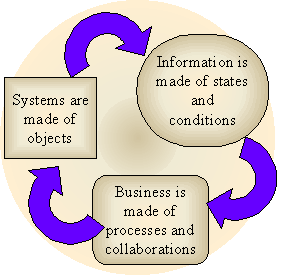
selected modelling languages
veryard projects > sebpc > modelling > modelling languages
 |
selected modelling languagesveryard projects > sebpc > modelling > modelling languages |
 |
| methods and languages reviewed on this page | other material | links | ||||||||||||
|
> modelling
> methodology |
 |
BPEL BPEL4WS BPMNveryard projects > sebpc > modelling > modelling languages > BPEL |
| SOAPbox September 1st, 2004 | |
| From Web Services to Web Collaboration (November 2002) restricted access | |
| Industry
Material |
|
| Blogs |
 |
ORDITveryard projects > sebpc > modelling > modelling languages > ORDIT |
J.E. Dobson and M.R. Strens, "Organizational Requirements Definition for Information Technology Systems", in IEEE International Conference on Requirements Engineering, Colorado Springs, CO, IEEE, 1994.
J.E. Dobson and R. Strens, "Responsibility Modelling as a Technique for Requirements Definition", Intelligent Systems Engineering, vol. 3, no. 1, pp. 20-26, 1994.
 |
SCIPIOveryard projects > sebpc > modelling > modelling languages > SCIPIO |
The SCIPIO method identifies
three ways of modelling a situation, to support strategic planning decisions
as well as tactical design decisions.
|
 |
 |
UML - Unified Modelling Languageveryard projects > sebpc > modelling > modelling languages > UML |
The extensions of UML do not significantly alter this. For example, a business modelling extension of UML aims to describe the (functional, computational, observable) behaviour of some business stuff.
UML expresses the kind of system/software requirements that can be tested by observing the behaviour of the system under test conditions. In theory (although not in practice) this may entail exercising every data permutation of every use case under normal circumstances.
There are all sorts of information system requirements that are not easily modelled in UML, and cannot be tested simply by observing the behaviour of the system under normal circumstances. For example, how do you express the privacy requirements on a customer database in UML? Security requirements, privacy requirement, safety-critical requirements -- these demand a different mode of requirements specification, and different approach for testing.
 |
VSM - Viable Systems Modelveryard projects > sebpc > modelling > modelling languages > VSM |
VSM is a normative model, identifying a number of elements that must
be present and properly balanced and connected in a "healthy" system. During
analysis, it can be used to identify the weaknesses of a given system.
During design, it can be used to produce a complete and balanced system.
| Viability
Notes on Balance Algedonic Signals |
|
| > Cavendish Software paper on Viable
Systems Model (pdf)
> Jon Walker guide to Viable Systems Model (html) > Presentation by Raul Espejo (1997) Giving Requisite Variety to Strategic and Implementation Processes: Theory and Practice (html) |
|
| Books | Stafford Beer, several including: Platform for Change (Wiley),
Brain of the Firm (Wiley)
Raul Espejo & Roger Harriden (eds), The Viable Systems Model (Wiley) |
| Tools | Download prototype modelling
tool from Cavendish Software
Note new URL for Cavendish |
 |
veryard projects > sebpc > modelling > modelling languages |
Copyright © 2002-4 Veryard Projects Ltd http://www.veryard.com/sebpc/languages.htm |